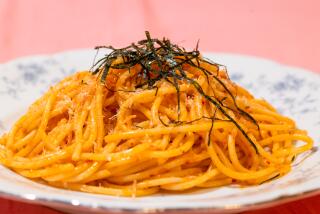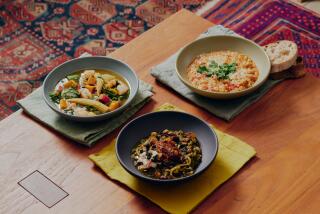Video tip: Fresh or frozen shrimp -- which is better? (and a recipe)

<p>Fresh or frozen? Los Angeles Times Test Kitchen director Noelle Carter explains why frozen shrimp may be a better choice.</p>
- Share via
When it comes to buying shrimp, “fresh” is not always better. Because they have such a short shelf life, most of the commercial shrimp we buy are caught, cleaned and quickly frozen (labeled IQF, or “individually quick frozen) before shipping to their final destination.
When you buy nonfrozen shrimp at the market, you’re almost always paying for the fish counter or market to thaw the shrimp for you, and you have no idea how long ago it was thawed. Buying the shrimp still frozen is often cheaper and more convenient (you can buy in bulk, thawing as you need them) than buying nonfrozen, and even safer.
Cooking is fun — at least it should be! No matter how long you’ve been in the kitchen, there is always something new to learn, whether it’s a simple twist on an old technique, or a handy tip to save time and energy. In this series of short videos, I demonstrate a variety of kitchen tips, ranging from how to hold a chef’s knife for maximum control to using a spoon to peel fresh ginger. If you have any gadgets, kitchen tips or questions you’d like me to explore, leave a comment or shoot me an email at noelle.carter@latimes.com.
SIZZLING SHRIMP WITH GARLIC AND HOT PEPPER
Total time: 25 minutes | Serves 4 to 6
Note: Adapted from “Mediterranean Clay Pot Cooking” by Paula Wolfert. She recommends using an 11- or 12-inch Spanish cazuela or straight-sided Flameware skillet. She also recommends using a heat diffuser for slow, steady cooking (especially if using an electric or ceramic stove top). Aleppo pepper can generally be found in Middle Eastern markets and cooking stores, as well as online. Marash pepper can be found at select Middle Eastern markets and online.
1 pound peeled small (about 60) or medium-large (24 to 30) deveined shrimp
1 scant cup extra-virgin olive oil, preferably Spanish
1 tablespoon finely chopped garlic
1 teaspoon mildly hot dried red pepper such as Aleppo or Marash
2 tablespoons hot water
1/2 teaspoon sea salt
1/4 teaspoon sweet pimenton de la Vera (smoked Spanish paprika)
4 to 6 slices chewy country bread
1. Rinse the shrimp and wipe dry with paper towels. Leave them at room temperature for 10 to 15 minutes so they are not ice-cold when they hit the pan.
2. Combine the olive oil, garlic and hot pepper in the cazuela. Set it over medium-low heat and warm the pan slowly, gradually raising the heat to medium or medium-high until the oil is hot. Continue to cook until the garlic sizzles and just turns golden, 2 to 3 minutes, stirring occasionally.
3. Immediately add all the shrimp and cook until they are firm and curled, 2 to 4 minutes, depending on their size.
4. Sprinkle with 2 tablespoons hot water and pinches of sea salt and pimenton. Serve at once right from the pot with the bread for soaking up the delicious oily sauce.
Each of 6 servings: 415 calories; 15 grams protein; 15 grams carbohydrates; 1 gram fiber; 33 grams fat; 5 grams saturated fat; 112 mg. cholesterol; 0 sugar; 470 mg. sodium.
Love cooking as much as I do? Follow me @noellecarter
More to Read
Eat your way across L.A.
Get our weekly Tasting Notes newsletter for reviews, news and more.
You may occasionally receive promotional content from the Los Angeles Times.










